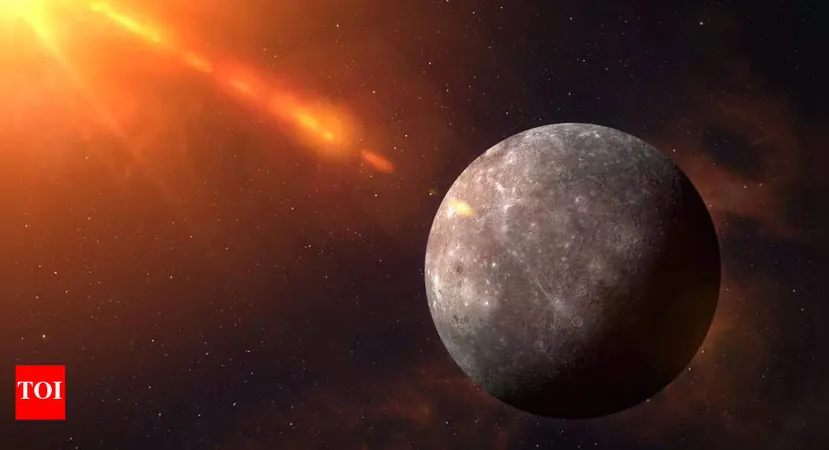
Unveiling Planet Y: Is This the New Puzzle Piece of Our Solar System?
2025-08-25
Author: Yu
A Cosmic Mystery Unfolds
Recent studies are hinting at an astonishing phenomenon in our Solar System—a warp in the orbital plane of Trans-Neptunian Objects (TNOs) between 80 and 400 astronomical units (AU) from the Sun. This anomaly may very well indicate the gravitational influences of a mysterious and yet undiscovered Planet Y, potentially smaller than Earth and orbiting at a staggering distance of 100-200 AU.
The Great Beyond: What We Know About Our Solar System's Limits
Since the dawn of space exploration, the true edges of our Solar System have remained shrouded in mystery. While Voyager probes have bravely ventured into the depths of interstellar space, our ability to trace the Sun's gravitational influence steadily diminishes with distance. Beyond Neptune lies a realm filled with icy celestial bodies that could very well be classified as planets. New research uncovered signs of a noticeable ‘warp’ in the orbital plane of TNOs—an exciting development that could be linked to the presence of Planet Y.
Evidence of the Distortion in Space
The research team meticulously analyzed the mean orbital plane of non-resonant TNOs, concentrating on those situated from 50 to 400 AU away. By excluding bodies that resonate with Neptune, they created a robust method to eliminate observational bias. Their remarkable findings indicate that the celestial bodies between 80 and 200 AU exhibit a tilt of approximately 15 degrees in relation to the Solar System's invariable plane. Statistical analysis concludes that this warp is unlikely to be mere coincidence, with only a 2-4% chance of it being random.
Could a New Planet Be the Culprit?
If this warp is indeed legitimate, researchers hypothesize that a planet, between the sizes of Mercury and Earth, is situated at a distance between 100 and 200 AU, tilted by more than 10 degrees could be the reason behind this inconspicuous distortion. Interestingly, a larger planet akin to Earth would warp the inner regions of the Solar System—a phenomenon we have yet to observe, making this scenario even more intriguing.
The Search for Planets X and Y
Amidst discussions about mysterious celestial bodies, Planet Y stands out distinctly from the often debated Planet Nine. If Planet Nine truly exists, it is theorized to be significantly larger, positioned far beyond our current observational reach at hundreds of AU. In contrast, Planet Y is theorized to be smaller and much closer.
What’s Next? The Vera Rubin Observatory's Role
The Vera Rubin Observatory's ambitious Legacy Survey of Space and Time (LSST) will soon put these theories to the test. As reported by IFLScience, if such a body as Planet Y exists but remains undetectable due to its position in the skies, the LSST will still shed light on the warp details within the Kuiper belt's mean plane. Should Planet Y hold some truth, it could have originated as another rocky embryo during the volatile early Solar System, ejected but possibly still lurking in the distant reaches of space.
The Cosmic Quest Continues
As we stand on the brink of new discoveries, the quest for understanding our Solar System's mysteries grows stronger. Could Planet Y be the next piece in the cosmic puzzle? Only time and further exploration will tell!
 Brasil (PT)
Brasil (PT)
 Canada (EN)
Canada (EN)
 Chile (ES)
Chile (ES)
 Česko (CS)
Česko (CS)
 대한민국 (KO)
대한민국 (KO)
 España (ES)
España (ES)
 France (FR)
France (FR)
 Hong Kong (EN)
Hong Kong (EN)
 Italia (IT)
Italia (IT)
 日本 (JA)
日本 (JA)
 Magyarország (HU)
Magyarország (HU)
 Norge (NO)
Norge (NO)
 Polska (PL)
Polska (PL)
 Schweiz (DE)
Schweiz (DE)
 Singapore (EN)
Singapore (EN)
 Sverige (SV)
Sverige (SV)
 Suomi (FI)
Suomi (FI)
 Türkiye (TR)
Türkiye (TR)
 الإمارات العربية المتحدة (AR)
الإمارات العربية المتحدة (AR)